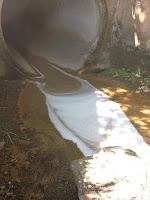 |
| Mangaiti Gully Restoration Trust's base camp. |
Restoration by the community for the community. If you are interested in receiving an email notification every time the blog is updated then register your email on gullyrestoration@gmail.com. Co ordinators are Rex Bushell 854-0973 and Rod Lugton 855-9966 .
 |
| Mangaiti Gully Restoration Trust's base camp. |
For those that are unfamiliar
with monitoring rats using tracking tunnels, these tunnels are left out all the
time, so rats get familiar with them in their territory and twice a year in the
spring and autumn we put an inked card in the tunnel along with peanut butter
as a lure. If rats are present, then they leave black ink footprints on the
card. This is a good way to record rat density. If no rats are recorded it does
not necessarily mean there are no rats but it does indicate that the population
is very low. We have 32 monitoring tunnels spread throughout the gully. This
November we recorded 1 card with rat prints, 2 cards with mouse prints and 9
cards with hedgehog prints. Overall an excellent result and a credit to all
those volunteers who service the 111 bait stations once a fortnight.
A copy of the “Tracking Tunnel Register”, is available in
the Mangaiti Gully Restoration Trust pdf
Library
 |
| Before |

 |
| A DOC file photo |
We have had reports in the past from residents of Millie
Place, which is in the same area, of skinks that fitted the description of rainbows,
but this is the first positive ID.
Rainbow skinks are a highly invasive Australian self-import.
They reproduce by laying eggs, unlike our indigenous skinks that give birth to
live offspring. This enables the rainbows to reproduce much more rapidly. There is no known means of eradicating them
once they are established without also eradicating our indigenous species. The
copper skink being our local one.
I purchased this book after reading an article in the winter
edition of the Forest & Bird magazine, that related to tui. The book’s
overall theme is that Australian birds are the origin, through evolution, of
all the songbirds in the world. The earlier theory (1800s) was that songbirds
evolved in Europe no doubt because they thought Europe
was the centre of their early civilisation. However, DNA and LNA testing has
exposed their folly. The book is in fact much wider than just songbirds. It delves
into the origin of nectar feeders and parrots, both of which Australia has many.
It investigated the relationship of birds’ unique habits with the equally
unique Australian flora. Many trees and plants have adapted, in some cases to
their detriment, to rely on their relationship with birds to reproduce either by
fertilising their flowers or to distribute their seeds.
To sum up, a quote from the book,” Australia has the
oldest songbird lineage as well as the wealth of form and behaviour that goes
with tens of millions of years of slow and steady diversification. The
evolutionary distance between a lyrebird and, say, a currawong, is larger than
that between any two songbirds in Europe or the Americas.”
A you tube clip of a lyrebird calling by David Attenborough:
https://www.youtube.com/watch?v=mSB71jNq-yQ
I found this a really fascinating book. The only thing I
struggled with was that I had little knowledge of the Australian bird (Baudin’s
black-cockatoo, mallee emu-wren) and flora names but google helped me out with
this as I went along. A good informative read.
9780143572817 (paperback) Penguin Random House Australia,
2017
Reviewed by Rex Bushell
We received this email from a gully neighbour: “Last week
a neighbour of ours who lives in Huntington saw a rat run from the gully across
his section and across the road. He chased it and eventually killed it with a
good old 4 x 2, three properties down. I wish I had it on camera.”
We wish you had a camera too! The rat was possibly a little groggy from snacking on a bait block from down in the gully!
 |
| The North Island Kōura Paranephrops planifrons |
 |
| Photo by NBC News |
 |
| New signs ready for installation |
 |
| Kimberly
Andrews, lead designer with husband James Innes |
 |
| The avian focus area is inside the red boundary line. |
 |
| Photo by Owen Cole |
 |
| A white-faced heron chick. A difficult photo shot because of the height above the ground and many branches. Photo by Owen Cole |
 |
| Photo by Rex Bushell |
 |
| Brown quail. Photo by Peter Reese (Not in Mangaiti) |
 |
| Cherries fruiting which cause all the problem |
 |
| Cherry seedlings coming up through out the gully |